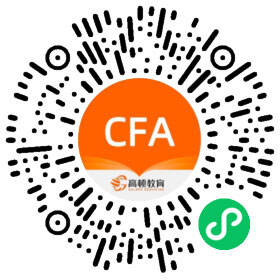
报考指南:2014年CFA考试备考指南
免费题库:2014年CFA免费题库
考前冲刺:CFA备考秘籍
高清网课:CFA考试网络课程



1、凡本网站注明“来源高顿教育”或“来源高顿网校”或“来源高顿”,的所有作品,均为本网站合法拥有版权的作品,未经本网站授权,任何媒体、网站、个人不得转载、链接、转帖或以其他方式使用。
2、经本网站合法授权的,应在授权范围内使用,且使用时必须注明“来源高顿网校”或“来源高顿”,并不得对作品中出现的“高顿”字样进行删减、替换等。违反上述声明者,本网站将依法追究其法律责任。
3、本网站的部分资料转载自互联网,均尽力标明作者和出处。本网站转载的目的在于传递更多信息,并不意味着赞同其观点或证实其描述,本网站不对其真实性负责。
4、如您认为本网站刊载作品涉及版权等问题,请与本网站联系(邮箱fawu@gaodun.com,电话:021-31587497),本网站核实确认后会尽快予以处理。
2023年CFA11月考试安排动态已经出来啦,有准别报考2023年11月CFA考试的小伙伴,今天学姐就来详细的为大家进行解答,一起来看看吧~ ...
2023-11-092024年2月北京CFA考纲发生改变,变化超50%,具体怎么回事儿呢,今天学姐就来详细的为大家进行说明,快来看看吧~ ...
2023-11-022024年5月CFA考试科目以及CFA考试形式已经全部公布,究竟怎么一回事儿呢,今天学姐就来好好跟大家聊聊这个话题,下面请跟随学姐一起来看看吧~ ...
2023-10-302024年8月CFA考试科目以及形式分别是什么样的呢,最近有不少小伙伴咨询到学姐这个问题,今天学姐就来好好跟大家聊聊这个话题,下面请跟随学姐一起来...
2023-10-25老师 为什么第二题不做处理呢 不应该计入资本公积—股本溢价吗
老师好,这道题的会计分录应该是这样的吧,但是我不理解其他综合收益2000那个步骤,他不是以摊余成本计量的金融资产已确认损失2000万吗?不应该是信用减值损失的科目吗?为什么写其他综合收益这个科目在这里?
老师您好,固定资产清理,卖掉时候,转银行存款和资产处置损益,差别在哪里呢。我觉得卖掉固定资产,转哪个都差不多啊,谢谢老师。
选项c,资本公积—股本溢价4500为什么不选?
收回前期已核销的坏账,坏账准备记录在贷方怎么理解
老师 为什么第二题不做处理呢 不应该计入资本公积—股本溢价吗
老师好,这道题的会计分录应该是这样的吧,但是我不理解其他综合收益2000那个步骤,他不是以摊余成本计量的金融资产已确认损失2000万吗?不应该是信用减值损失的科目吗?为什么写其他综合收益这个科目在这里?
老师您好,固定资产清理,卖掉时候,转银行存款和资产处置损益,差别在哪里呢。我觉得卖掉固定资产,转哪个都差不多啊,谢谢老师。
选项c,资本公积—股本溢价4500为什么不选?
收回前期已核销的坏账,坏账准备记录在贷方怎么理解
2024年2月cfa考试结果公布时间是什么时候?,最近有准备考2024年2月份考试的小伙伴咨询到学姐这个问题,今天小编就来统一为大家进行解答,下面请跟随学姐一起来看看吧~...
2023-11-222024年11月CFA备考策略有哪些,有准备报考2024年11月CFA考试的小伙伴看过来,今天学姐就来详细的为大家讲解一下啊关于CFA备考那些事儿,一起来看看吧~...
2023-11-102023年CFA11月考试安排动态已经出来啦,有准别报考2023年11月CFA考试的小伙伴,今天学姐就来详细的为大家进行解答,一起来看看吧~...
2023-11-09What kind of model is the CFA Certificate Level 1, Level 2, and Level 3 exam, and how are the exam question types distributed? Today, my senior sister will analyze it in detail for everyone, let's take a look together~...
2023-10-112024年CFA考试科目难点有哪些?有准备或者打算参加2024年CFA考试的小伙伴咨询到学姐这个问题,今天学姐就来统一为大家进行解答,下面请跟随学姐一起来看看吧~...
2023-10-092024年CFA一级考试大纲+CFA一级教材进行汇总啦,今天学姐就来详细的为大家进行解答,下面请跟随学姐一起来看看吧~...
2023-10-042023年11月CFA考试位置有哪些?马上要到十一月份考试了,相信有许多小伙伴对于11月考试有许多疑问,今天小编就来详细的为大家进行解答,一起来看看吧~...
2023-09-12CFA是什么证书2024年CFA含金量究竟如何?2024年CFA考试报名已经开始了,是否有很多考生还在犹豫,对CFA还不是很了解,也不知道CFA证书含金量到底怎么样?今天小编就来好好跟大家讲讲这个话题,一起来看看吧~...
2023-09-28cfa道德7准则分别指的是什么?刚接触CFA的时候,有同学会认为CFA考试三个层次有十个科目,每个层次都有不同的科目;但是通过后期的了解,我们会明白情况并非如此。这个时候,估计不懂CFA考试的同学会很困惑。CFA道德7准则到底是什么呢,今天学姐就来带领大家啊一起来一探究竟,一起来看看吧~...
2023-09-07cfa证书考试难度如何每年通过率高吗?最近有小伙伴咨询到学姐这个问题,今天学姐就来好好跟大家讲讲关于CFA考试难度那些事儿,一起来看看吧~...
2023-09-05CFA是“特许金融分析师”的简称,它是证券投资与管理界的一种职业资格称号,由美国“特许金融分析师学院”发起成立。那么考过CFA证书有什么用呢?今天学姐就来好好聊聊这个话题吧~...
2023-09-01如何有效备考2024年CFA三级考试?最近有小伙伴咨询到学姐这个问题,今天学姐就来好好跟大家解答一下这个问题,下面请跟随学姐一起来看看究竟怎么一回事儿吧~...
2023-08-28